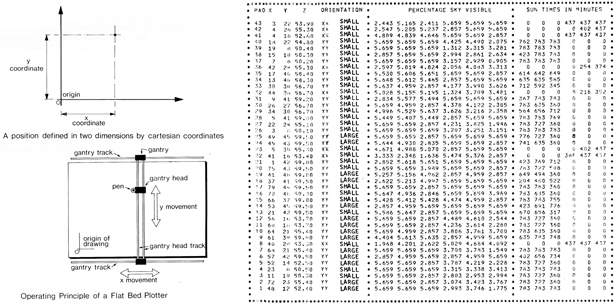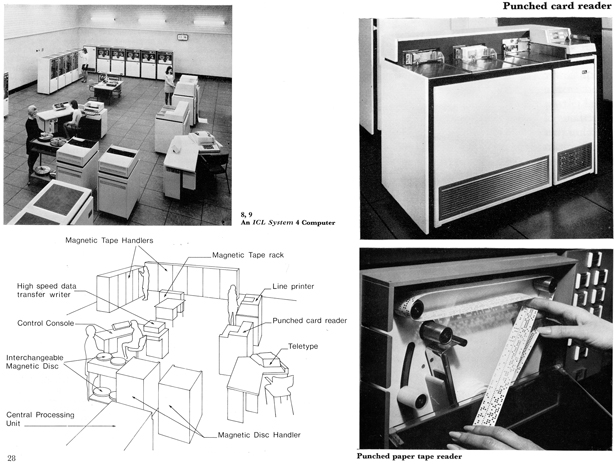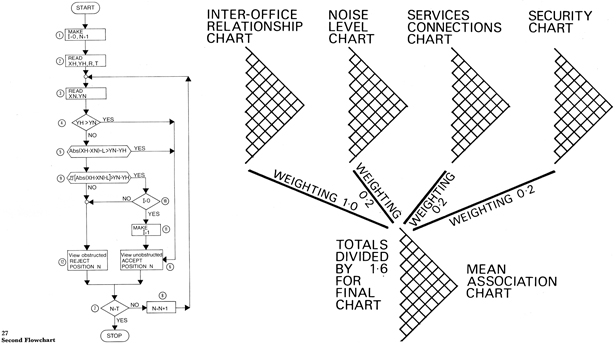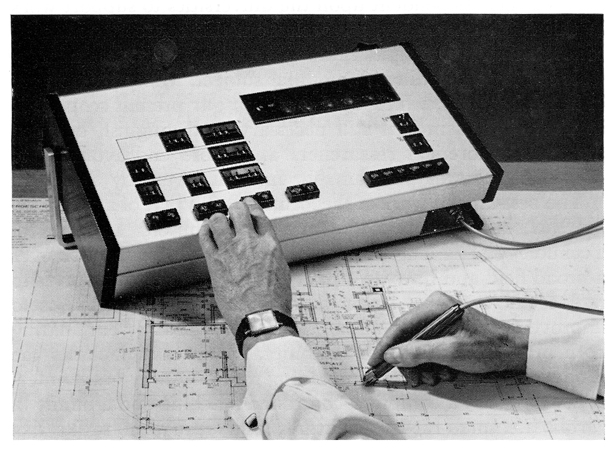WORD PROCESSOR: HIGHLIGHTS FROM THE COLLECTION
January 22, 2014
The Architect and the Computer
Christopher Beccone

Descartes
In considering Boyd Auger's 1972 book, The Architect and the Computer, it is tempting to dismiss it as a particular historical oddity. Part history, part advertisement and part How-To manual, it is an interesting snapshot of the architectural profession just prior to the migration of digital computing into the workspace and workflow of the professional office.
Auger sets out with a brief history of the role of the Architect in society, beginning with the guild system, through the elevation of the master builder and arriving at the station of the Architect as a Universal Man (L'Uomo Universale), which he locates with Leon Battista Alberti around 1450. The decisive break being that Alberti was the first patrician who built without a craft training, rather an academic one.
As the origin of patrons changed through the centuries, from the church, to royalty, nobility and the middle class entrepreneurs of industry by the mid nineteenth century, architecture and architects absorbed and moved with these shifts as necessity dictated. Architecture has always been expensive, and where the wealth of the Society migrated, Architects soon followed.
The central thesis of his book soon emerges as he tackles the 20th century, with its explosion of materials sciences and construction and fabrication technologies. Auger fears that the resulting information density will potentially lower the status of the profession, as areas which had previously been within the realm of architecture began to be 'peeled off' and solidified in other professions; structural engineering, civil engineering, mechanical, electrical, plumbing, acoustics, etc. His level of alarm at the continuing diminishment of the profession is raised considerably by the new availability of digital computing power, which due to its nature of massively speeding up calculation, had migrated into the engineering fields. From his vantage point in 1972, Architects were in grave danger of being swamped by quantification and speed.

Thus begins the central mission of the book, in order to play in the computation arms race, the solution is clear: Architects must embrace the computer as a modern tool and learn to integrate it into their practice. According to Auger, this is the way forward to managing the overwhelming quantity of data that any architectural project must address in order to be successful. Additionally, but placing architecture on a digital footing, it becomes ipso-facto a contemporary mode, and is given additional utility through direct interface with the output of the engineer. As a practical issue, the deterministic formulas and output of the engineering world was already largely digitized, and information which arrived in the architect's office from the consultants was arriving faster, and with greater certainty of its correctness. The computer could, after all, calculate optimum solutions to well-defined formulas (the essence of Engineering) with incredible speed. Not only that, but Engineers were able to test and propose solutions which had been simply unattainable without the aid of computers.
A well-intentioned but unfathomably tiresome trudge through computer basics consumes the remainder of the book. From the simple (defining a Central Processing Unit, what constitutes a peripheral, methods of input and output), through an examination of the commercially available systems, their relative merits and costs and alternative strategies for small offices to gain access to mainframe computing power (timesharing), it finishes up with a discussion of then-contemporary computer languages.
It is important to realize and review the condition and rate of expansion of the digital universe. In 1972, the Graphical User Interface (GUI), the most salient component of human/computer interaction today, had not been developed. AutoCAD, now considered the Ancien Régime of digital design drawing programs, was 10 years in the offing, and even early versions of that program were command-line driven. The concept of interacting directly with the screen of the computer was even further down the road. In order to operate one of the systems Auger was proposing, the architect would in essence need to become a coder, FORTRAN being the principal language in design use at the time.

It is then a bit of a stretch to imagine how the practitioner of a graphic language should devote the time, energy and resources to acquiring a purely symbolic one, in the interests of gaining disciplinary currency. Auger is on a difficult mission, and to his credit, he is fully aware of this. The depth of rational, computational minutiae to which he travels is impressive, yet looks for all the world like a foolish mission. Even given the rational, 'Organization Man' culture which was still ascendant in architecture at the time, it was easy to discern (I assume that I am not being Historicist here by saying, even for contemporary observers) that even if computers could successfully tackle the functional bits of architectural practice, the vast, subjective areas of site specificity, client and architect desires, cultural meaning, beauty, and prestige, to name a few, were well beyond any formulaic treatment and thus simply digitally un-computable.
There were some glints of possibility on the horizon however. Namely the digitizing pen and the drum and table plotters. These highly specialized pieces of equipment were starting to become commercially available around the time, and Auger is quick to locate their potential within the practice. By means of these devices, the language of architectural communication could be crudely approximated, and through the process of digitization, the information could be stored, a critical feature. From stored cartesian points, vectors could be drawn, and the resulting geometric information could be used to produce new drawings by specifying where to cut the assemblies.

Hoval calculator and measuring stylus
Although hampered by the relative slowness of moving the pen around and entering coordinates by means of a hand-held clicker, here was a possible method of harnessing computation. In one of his more prescient statements, Auger imagines a system in which geometry could be linked to empirical information about the physical materials which is described by that geometry. The resulting database could then be utilized to develop costs and quantities of building projects, as well as checking in advance, that all of the building components could actually be placed correctly in relation to each other. Recently, a branch of architectural modeling software known as BIM (Building Information Modeling), has begun to achieve exactly that. Building assemblages are increasingly described fully as digital models which allow for industry-standard components to be checked at a very fine level of detail prior to site construction.
Leibniz
"I can see no essential difference between the materialism which includes soul as a complicated type of material particle and a spiritualism which includes material particles as a primitive type of soul"
-Norbert Wiener, 1934
Upon further consideration of the book, this jumps out:

Curious. Why would an essentially Rationalist text that is arguably relocating Architecture to its most reductive Cartesian operations be dedicated to the comic foil of Voltaire's Candide, a text that went out of its way to paint Leibnizian Optimism as a punch line?
One obvious possibility is that Auger is simply slyly attempting to shine a light on Leibniz's development of the binary number system and the invention of the shift register, the arguable first working proof of universal binary computation, in 1679. Ever since the early part of the 20th century, specifically with the formulation of Heisenberg's Uncertainty Principle and Gödel's Incompleteness Theorem, Leibniz's work, which had reached a low point of ridicule in science and culture generally, had been regaining respect and status as a complement to Cartesian Rationalism.
It is tempting to consider another possibility, one which proposes a stronger connection between computation in architecture in 1972 and 2014. As the inventor of topology, Leibniz is further brought back into currency as the iterative functioning of high speed digital computing increasingly produces solution sets for physical phenomena (shock wave propagation, weather modeling, gravitational effects, etc.) that are topological, not cartesian in nature. In other words, the digital computer is increasingly allowing us to quantify and manipulate topological space, an ability unforeseen and an unexpected, emergent consequence of iterative computation.
What this means is that we now possess a spatial mode of representation which was previously unavailable. Architecture has always contained representation as its critical method, and the 2-dimensional analogue of the drafting table which was being proposed in 1972 is understandable in its direct lineage to the history of architectural drawing and particularly the section drawing. Today, far from being constrained by 2d representation of 3d space (Architecture being the Art which has space as its medium), our tools have expanded our abilities to describe and fabricate in 3d and 4d space. We have not left the Cartesian—2d representation is still a widely-used mode and very few buildings are built without resorting to it, but architectural language and the syntax of architectural representation has been radically expanded.
Auger was right to propose computation as a way forward, and the effects of bringing the computer into the realm of architecture have returned a vitality to the discipline, one which has pushed representation forward and created new areas of collaboration and conflict between the architect and the engineer.
From his standpoint in 1972, there would have been no possibility of predicting the degree and depth to which the computer would inhabit and augment architectural practice. In particular, the degree to which architects interface with the computer as a matter of course has been total, from front-office procedures, legal record keeping, product research and communication, through to the design process itself. 3d modeling programs which have native facility with non-uniform functions and geometries, as well as computer-aided output both additive (plotting, 3d printing) and subtractive (CNC milling) have all become well within the reach of many offices and are now taught as a matter of course in almost every school of architecture worldwide. The sea-change in the discipline is complete and comprehensive and has allowed architecture to reclaim areas of expertise which were seemingly in danger of slipping away, as well as locate new areas to incorporate into the discipline, leaving it as fragmented, nervous and full of possibility as any other epoch in its History.
Christopher Beccone, RA, NCARB, has a bachelor's degree from Macalester College and an MArch from The University of California, Los Angeles AUD. He has taught undergraduate design studios in UNM's School of Architecture for several years and has concentrated on design methodologies and integrating digital representation and fabrication processes into the studio. He maintains his own practice and is currently working on projects in California, New York and New Mexico. Prior to teaching at UNM, he has worked at Coop Himmelb(l)au, and as an Associate at Antoine Predock Architect. He has travelled and worked on all phases of buildings in North America, Asia, Europe and the Middle East.
View The Architect and the Computer in the catalog.
